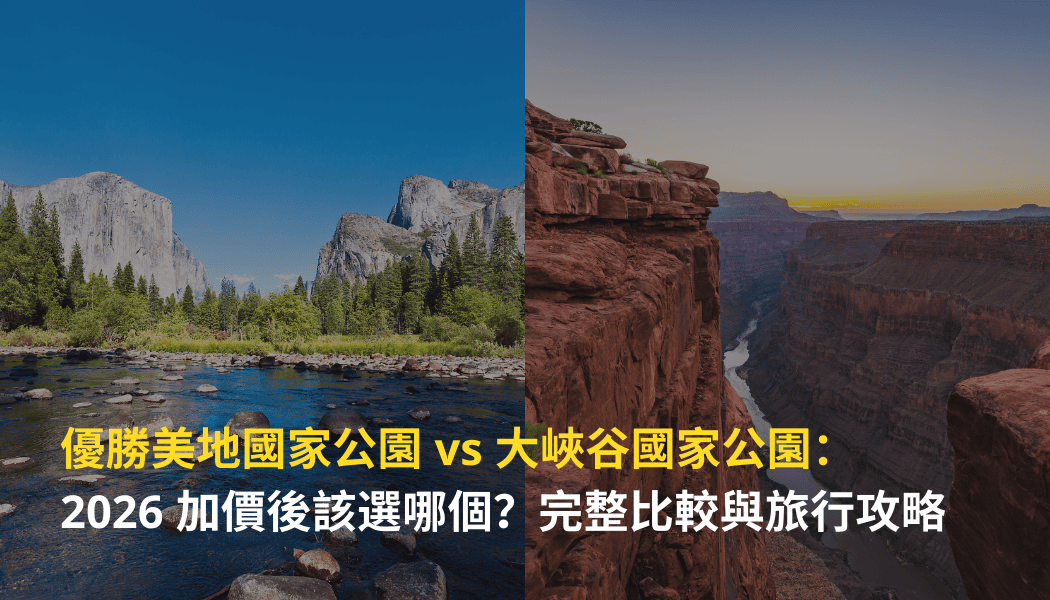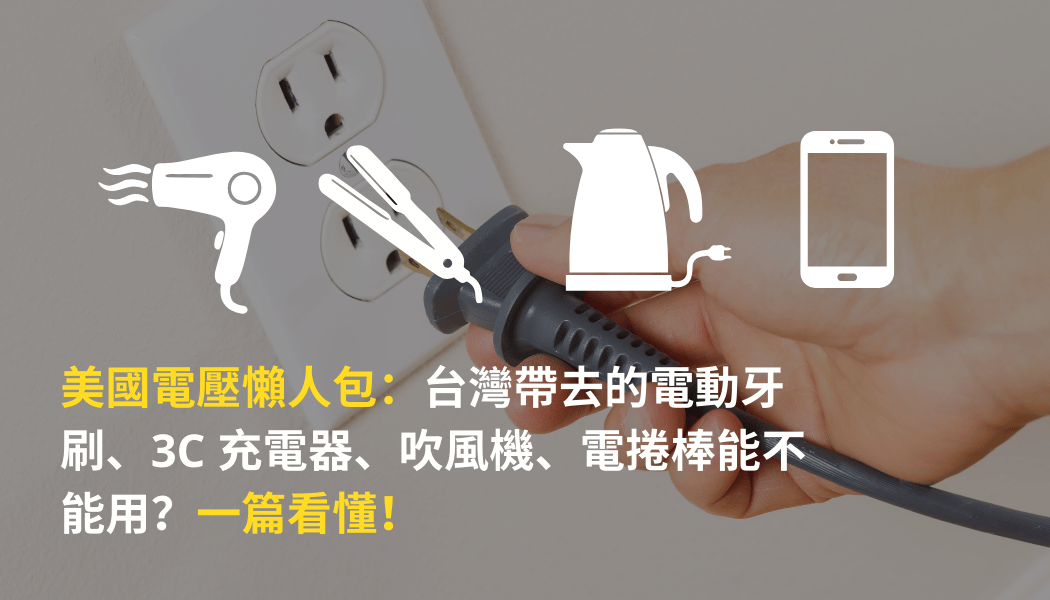
The United States is a vast country, and for travelers planning to visit the United States for sightseeing or business, renting a car is the most convenient and flexible way to get to most places, especially in cities such as Los Angeles and Las Vegas, where public transportation is not as well-developed as it could be. Renting a car makes it easier to move long distances across state lines, go to national parks, and get to and from various parts of the city in a time-efficient and safe manner. Therefore, we have compiled the latest "US Car Rental Guide 2025" to help you understand the details of car rental in the United States, from the booking process, required documents, car models and car rental insurance options, to local driving rules, pick-up and return of the car, so that you can rent a car in the United States, even if you are unfamiliar with the United States, to visit the major beautiful attractions with ease and peace of mind!
Highlight the finishing touches:
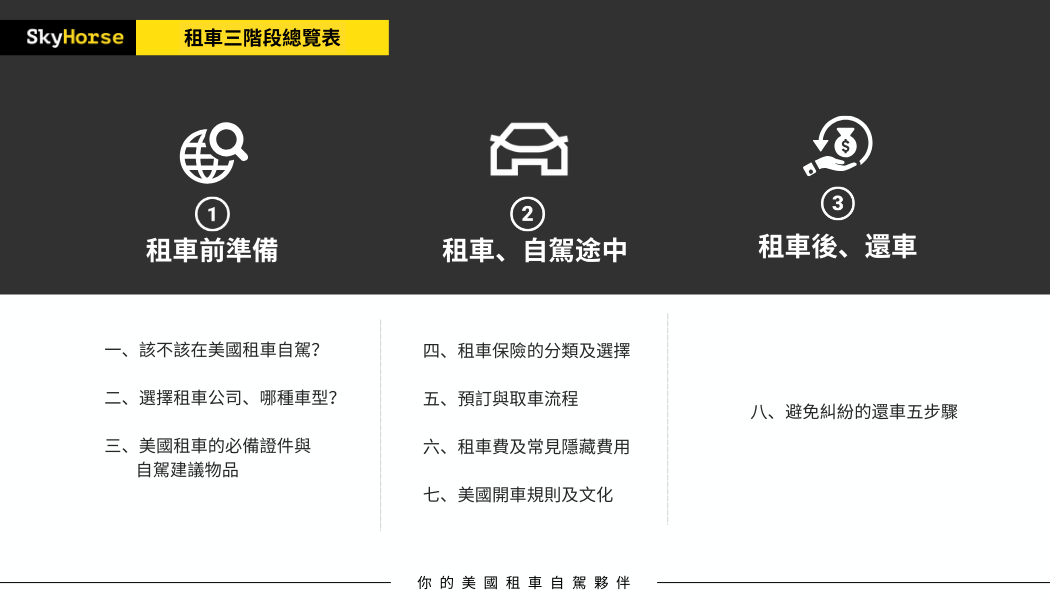
Should I choose to rent a car and drive in the U.S.?
The United States is a typical car-oriented country, with major highways running through every state, city and town, and most locals use cars as their main mode of transportation, regardless of urban planning or distribution of scenic spots. Compared to the time-consuming and inaccessible places of the public transportation system, renting a car and driving allows travelers to plan their trips more freely and flexibly, and makes it easier for them to visit spectacular national parks and travel through villages and towns with a very American atmosphere.
For travelers with limited vacation time, driving by yourself can save time on transportation transfers and make it easier to carry luggage or do shopping!
Especially in the U.S., where the highway system is well developed, there are few motorcycles on the road, and drivers are generally law-abiding. For travelers from Taiwan, as long as you have a complete understanding of what you need to know about renting a car, it's not difficult to drive in the U.S. Even ifBad English.Nowadays, there is also a Taiwanese founded Sky Horse Chinese car rental company to serve travelers, so there is no need to worry about the language barrier.
If you want to deeply experience the local culture and landscape of the United States, driving is definitely the best way. The highway scenery, small towns, and specialty food along the way will greatly enrich the excitement and level of your trip to the United States.
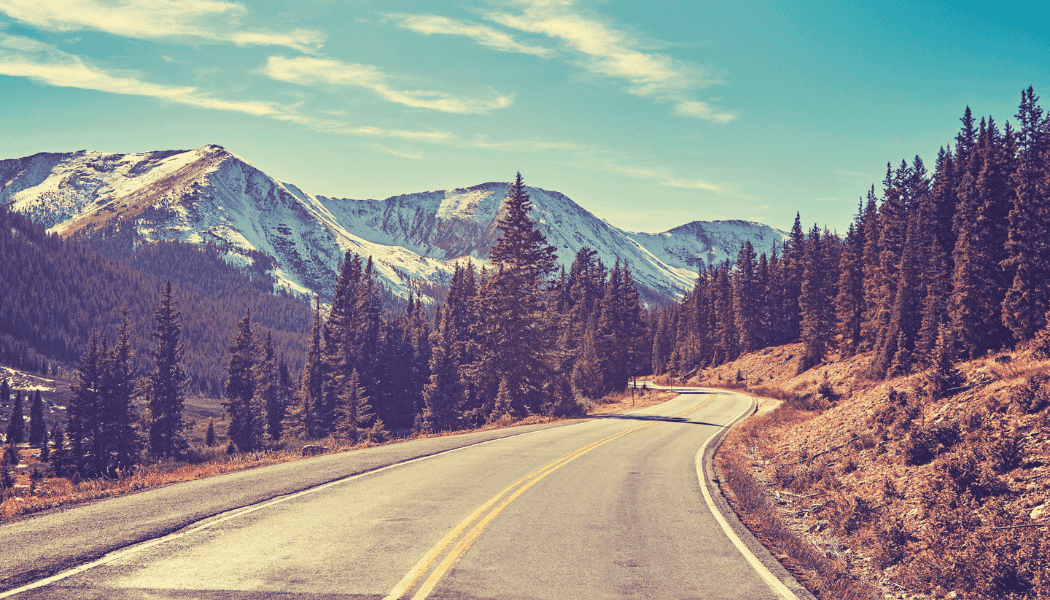
How to choose a car rental company and what type of car should I choose?
Keys to Choosing a Car Rental Company
First of all, after deciding on a self-drive tour to the United States, you will be faced with the difficult question of how to choose a car rental company. When evaluating the right car rental company, you should consider the following key factors instead of just looking at the rental rate alone:
- Real Total PriceIn addition to the rental fee itself, there are insurance, taxes, airport surcharges, extra driving fees, additional equipment, and so on, that make up the actual cost of the rental. Many car rental companies will add extra hidden charges at the checkout, making the final bill much higher than expected.
- Quality of Service: By looking at reviews on the internet (see Google Maps, Reddit, PTT,FB California Travel ClubIf you are traveling in an unfamiliar country, it is important to know the quality of service provided by each company, especially if there are negative complaints. When traveling in an unfamiliar country, good and honest service is crucial. Be especially aware that service may vary from one office to another.
- Convenience of picking up and returning a vehicle: Make sure that the opening hours are compatible with your flight schedule. Some airports may have car rental centers located farther away from the main terminal and require a shuttle bus, which should also be taken into consideration.
- Rent-A-Buy-Back Policy: If you plan to pick up or drop off the car in a different city, check to see if this is allowed and how much extra you'll have to pay. Some companies' One Way Fee can be more than double the rental fee.
- Emergency Service Support: Understand the car rental company's roadside assistance service and contact details, as having a quality 24-hour customer support service can be a lifesaver in the event of an emergency.
Compare Car Rental Companies
In the case of California car rental, Taiwan travelers usually choose American chain car rental companies. If you are worried about English communication, you may consider switching to a Chinese car rental agency. In fact, every car rental company has its own advantages and disadvantages, you can follow the advantages and disadvantages of the following points of consolidation, choose to choose the right car rental company, not only related to the travel budget, but also directly affects your self-drive travel experience.
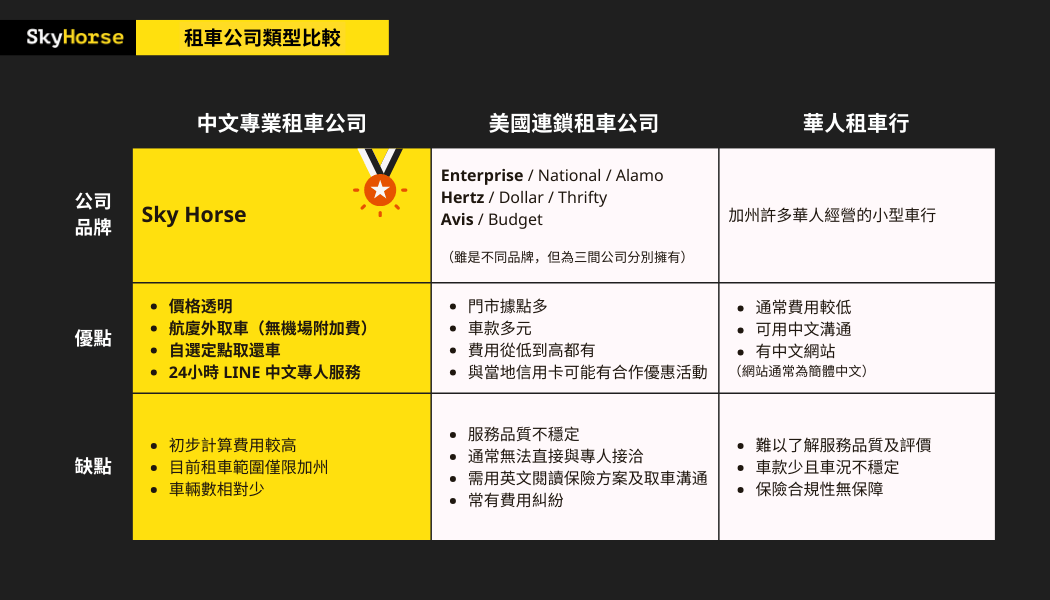
Select model, trim level
The following chart will give you a better idea of the models and trims of cars commonly rented in the United States, as well as the number of passengers and luggage that can be accommodated, so that you will have a better idea of what type of car you are looking to rent!
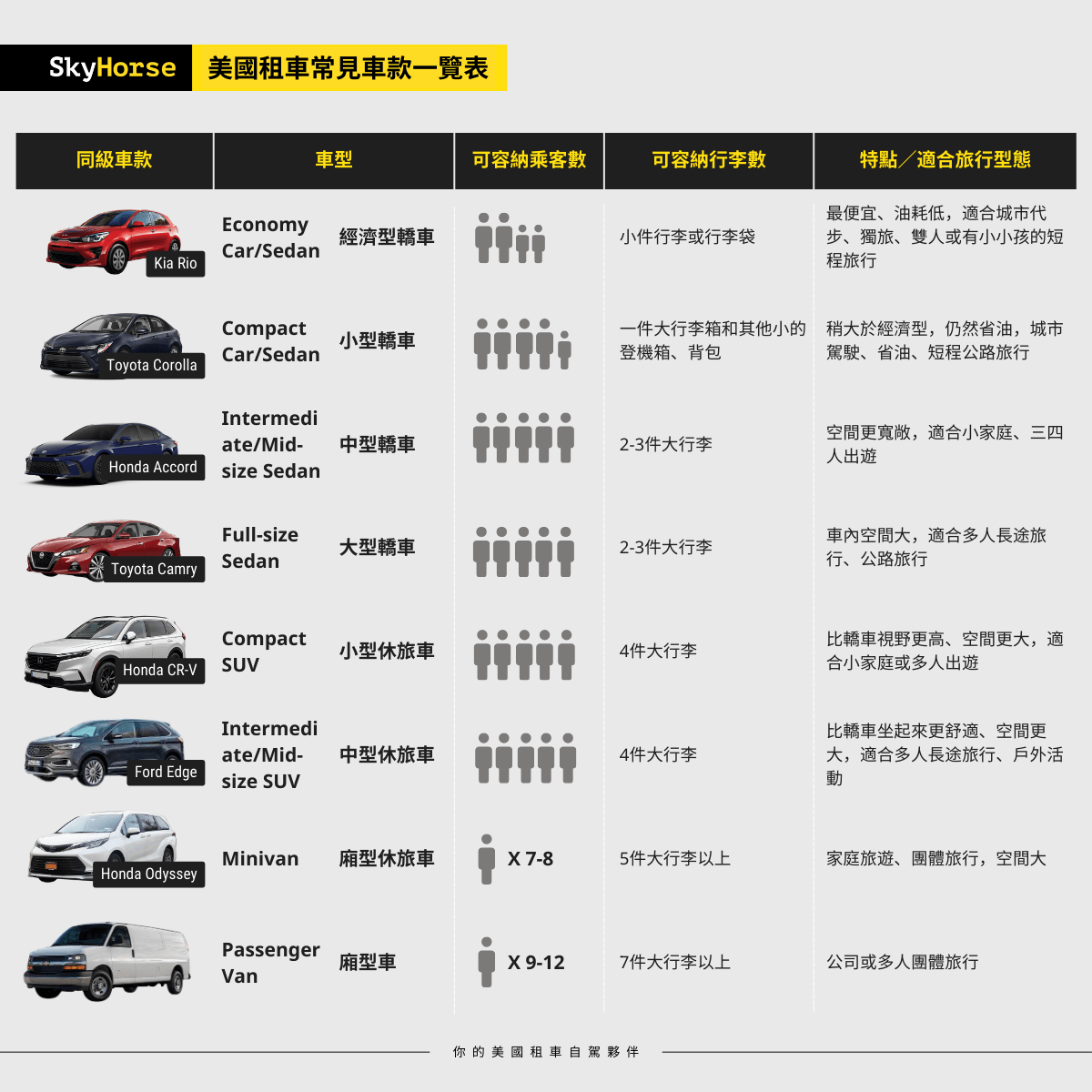
Required Documents and Recommended Items for Renting a Car
When packing your luggage, remember to have the following five important documents to ensure that you won't run into problems when renting a car in the United States:
1. Valid Driver's License: An official driver's license is mandatory and should be valid for the entire duration of your trip.
2. International Driver's License: Although some states recognize Taiwan driver's licenses, it is highly recommended to apply for an international driver's license in order to avoid unnecessary hassles.
3. credit cards: The primary driver's own credit card must be used when renting a car, and this card will be used for the pre-authorized deposit. (It is recommended to have two or more credit cards from different issuers and banks in case one card is declined and another is available).
4. Passport: Proof of identity, passports must be carried at all times and are guaranteed to be valid for the duration of the trip.
5. Confirmation Information for Rental Car Reservations: It is advisable to print out the confirmation email or reservation number received after booking or keep it in your cell phone to show it when you pick up the car and to avoid disputes with the car rental company.
In addition, you can also carry extra of the following items to ensure a smooth trip:
1. Mobile phone cable: convenient for charging in the car, connecting to Carplay to view maps or listen to music.
2. GPS: Most people now use Google Maps for navigation, but if you are used to using GPS, you can also bring your own to avoid the situation where the rental company does not provide it, and to save the rental fee.
3. Thermal bag: In the United States driving long hours, if you want to drink cold drinks, or for the purchase of food to keep fresh, you can bring more convenient.
4. Sunglasses: The U.S. has strict regulations on the use of automobile insulation paper. Driving under strong sunlight, without sunglasses, the driver and front-seat passengers may be very uncomfortable.
5. Infant/child car seats: If you have children traveling with you, some families bring their own safe and comfortable car seats, which saves you the cost of renting them from a car rental company.
6. Large water bottles: If you are traveling on a long road trip and do not want to buy large quantities of bottled water, you can use a water bottle to fill up water from a hotel, or ask a restaurant to help you fill up water during a meal.
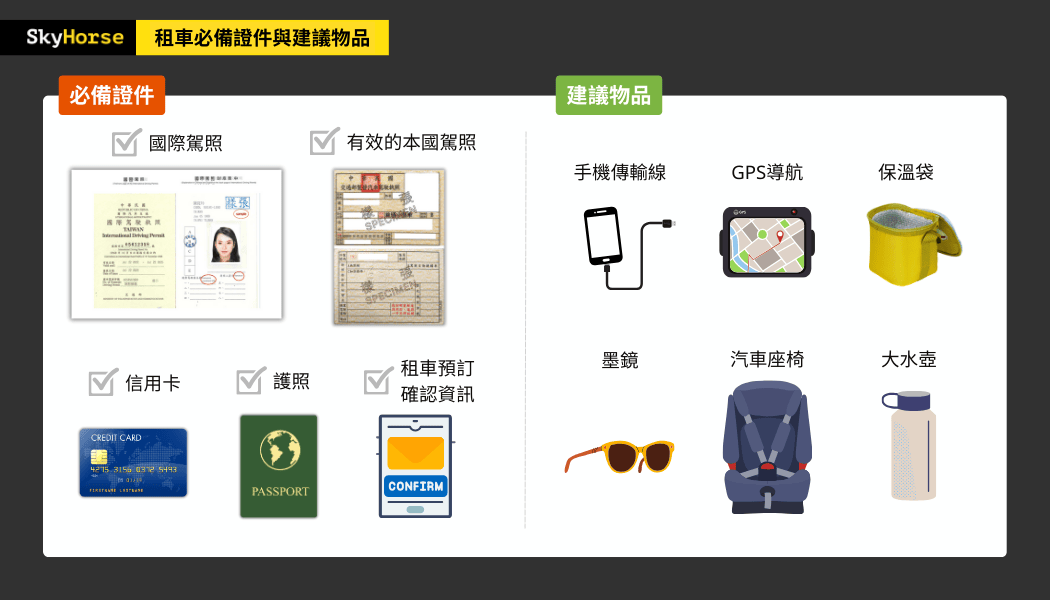
Classification and selection of rental car insurance
There are many different types of insurance available for rental cars in the U.S. Understanding the contents and necessity of each type of insurance is the key to a safe and secure trip:
Necessary Insurance (highly recommended):
Collision Damage Waiver (CDW)
Coverage: Covers the cost of repairing damage caused by collision of the rental car.
*Note: This is not true insurance but a waiver of liability, and in many cases the renter is still responsible for the deductible.
Loss Damage Waiver (LDW)
Coverage: Add coverage for non-collision losses, such as vehicle loss, natural disasters, etc. on top of CDW.
*Note: The above CDW and LDW may not include damage to windows (windshield), tires, chassis and other parts.
Third Liability Insurance (Supplementary Liability Insurance, SLI)
Coverage: Covers bodily and property damage to third parties.
*Note: Although the incidence rate is low, medical expenses in the United States are high and coverage is recommended.
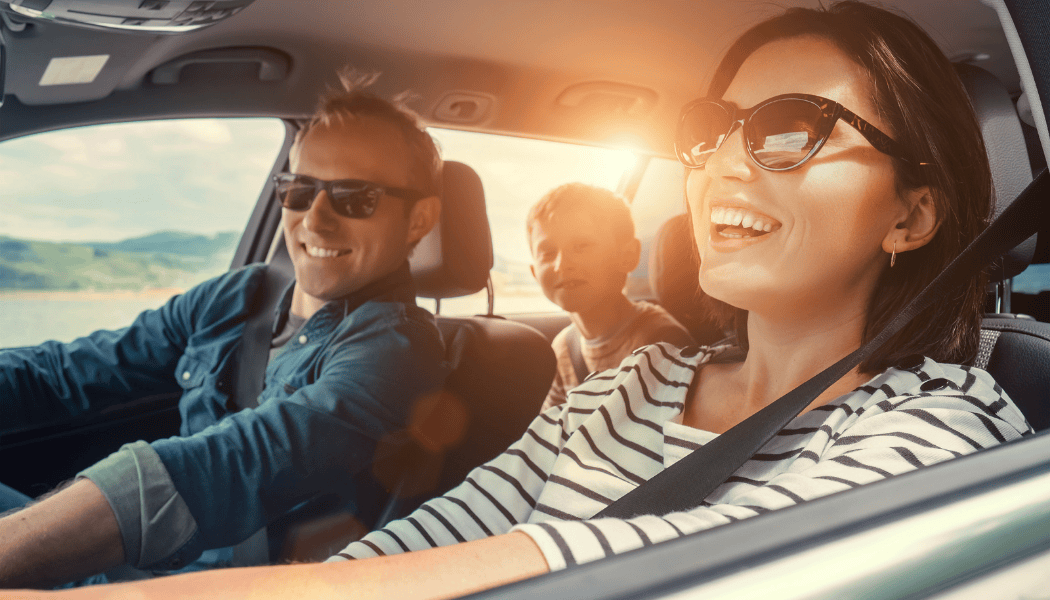
Optional Supplementary Coverage
Personal Accident Insurance (PAI)
Coverage: Covers medical expenses for the driver and passengers.
Necessity: ★★★☆☆☆☆☆ (can be omitted if there is a perfect travel safety insurance)
Personal Effects Coverage (PEC)
Coverage: Covers loss or theft of personal property in the vehicle.
Necessity: ★☆☆☆☆ (may be omitted; if driving in urban areas, no items should be left in the vehicle)
Roadside Assistance (RAS)
Coverage: Provides emergency assistance for flat tire, no fuel, locked car, dead battery, and other emergencies.
Necessity: ★★★★☆☆☆ (depending on the itinerary, it's worth adding insurance if you plan to travel to remote areas)
Sky Horse offers insurance packages designed to meet the needs of overseas travelers, covering essential coverage while avoiding duplication of expenses, with transparent pricing and no hidden costs, and without being forced to sell unnecessary insurance items. In Plan B and C, we have strengthened the coverage for windows, tires, and chassis, and further insured against damages during vehicle maintenance, loss of keys, and other details. We understand that Taiwanese tourists are unfamiliar with the U.S. insurance system, so we provide full Chinese explanations and clear pricing on our website to ensure that travelers can make the most suitable insurance choices for themselves.
- A more complete description of the insurance coverage is available:U.S. Rental Car Insurance
V. Booking and Pickup Procedure
To rent a car in the United States, you usually need to make a reservation online in advance, and the process is roughly as shown below:
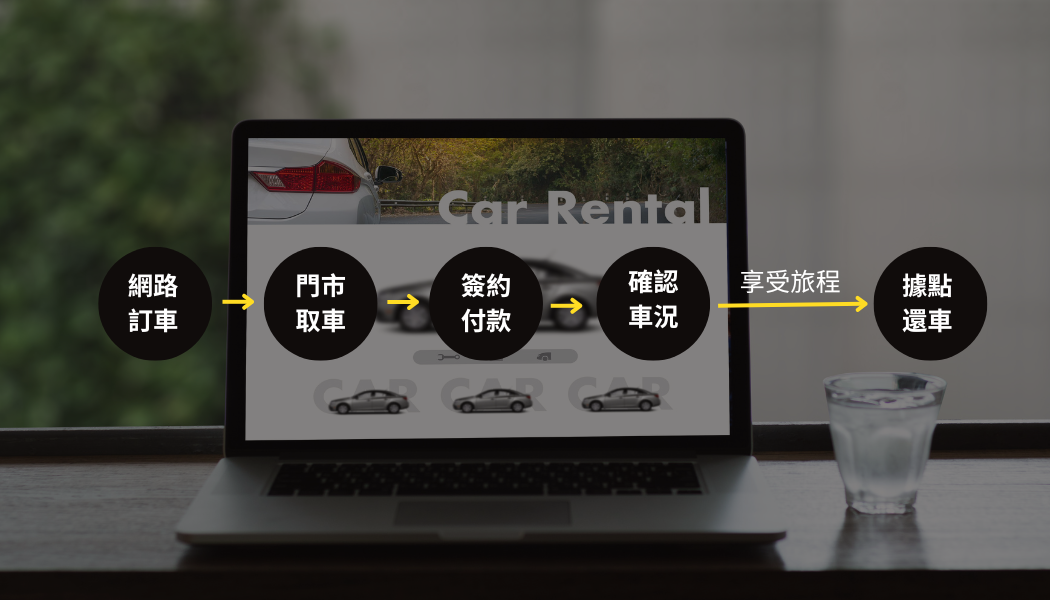
Once you've chosen your car rental company, car type, and insurance, you can book your rental car online, and remember to check a few things at this time:
- Total Price BreakdownIf you have any questions, please contact us to confirm which items are included in the fees presented at the time of booking (many).Affordable Car Rental Platform(To attract customers, lower prices are shown, but in reality many of the costs are not accounted for.)
- Is there a mileage limit for this model?Most cars have no restrictions, but it's always better to check first to avoid being charged later.
- Pick-up and drop-off locations and timesIn addition, you should pay particular attention to the business hours of the outlets, as some of them are unable to pick up or return a vehicle after business hours, while others have to add an extra fee for picking up a vehicle during non-business hours.
- Cancellation and modification requirementsWhat are the restrictions on canceling or rescheduling a trip? If I need to change my itinerary due to a change in schedule, flight delay, etc., are there any restrictions on canceling or rescheduling?
- Secure Credit Card LimitThe deposit is usually pre-authorized at the time of booking or picking up the vehicle and will be refunded after the vehicle has been returned.
Pickup process and notes
If you are picking up your car at the airport, it is recommended that you confirm the location of the terminal building relative to the rental car company's counter in advance. In large airports, such as San Francisco Airport (SFO), the rental car company's counter will be centrally located in the Rental Car Center, or outside of the airport, and you will need to take the Airport Express or shuttle bus to reach it. Knowing these details in advance will save you time and energy when you are carrying your luggage. Knowing these details in advance will save you time and energy in carrying your luggage around.
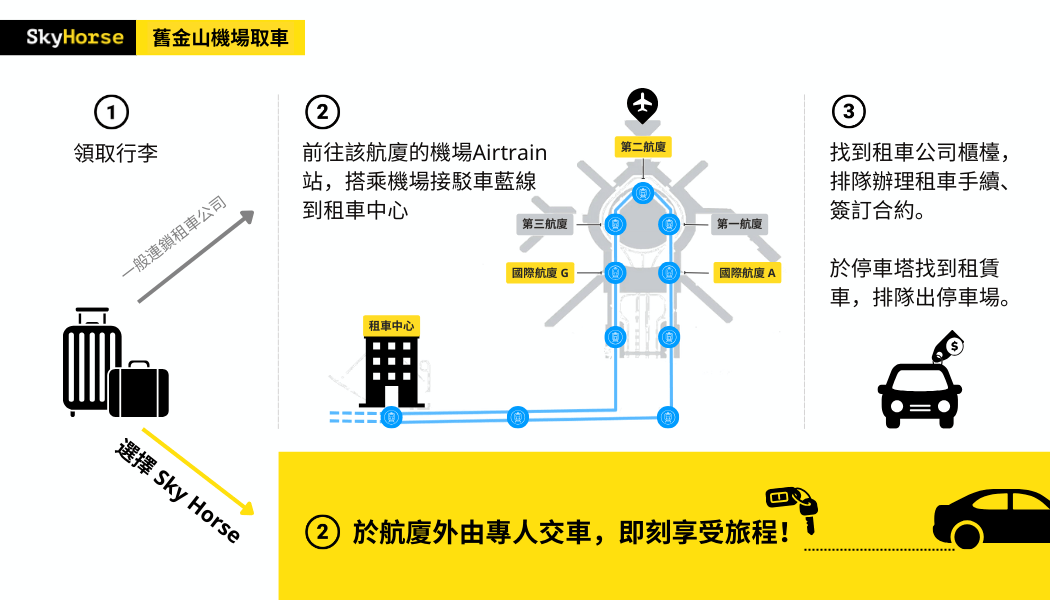
In addition, it is recommended to keep the phone number of the rental company (especially the phone number of the pick-up point) so that you can communicate with them immediately if you need to coordinate or delay the rental time. Travelers can alsoRequired DocumentsIt saves time when searching for the rental car. The rental agent will check your passport, international driver's license, and local driver's license to verify your reservation. If there is an additional driver, the additional driver's license must be provided as well.
Under normal circumstances, the car rental company will offer a choice of cars of the same class available on site, and then print out a document confirming the rental period, car type, and insurance with the traveler, so it is important to make sure that it is the same as the original reservation. Sometimes unscrupulous operators may add unnecessary hidden fees such as prepaid fuel, unselected or upgraded insurance plans, etc. Travelers should check carefully to avoid paying more than expected. Read the terms and conditions of the contract carefully and if everything is in order, sign the rental contract and pick up the car from the parking lot/tower.
🚧 Warm reminder:Rent a car from Sky HorseThe car can be picked up directly from the terminal building, which saves a lot of time and steps.
Five key points for vehicle inspection when picking up your car
Before confirming that you have rented the vehicle, and before driving away, be sure to thoroughly inspect and record the condition of the vehicle:
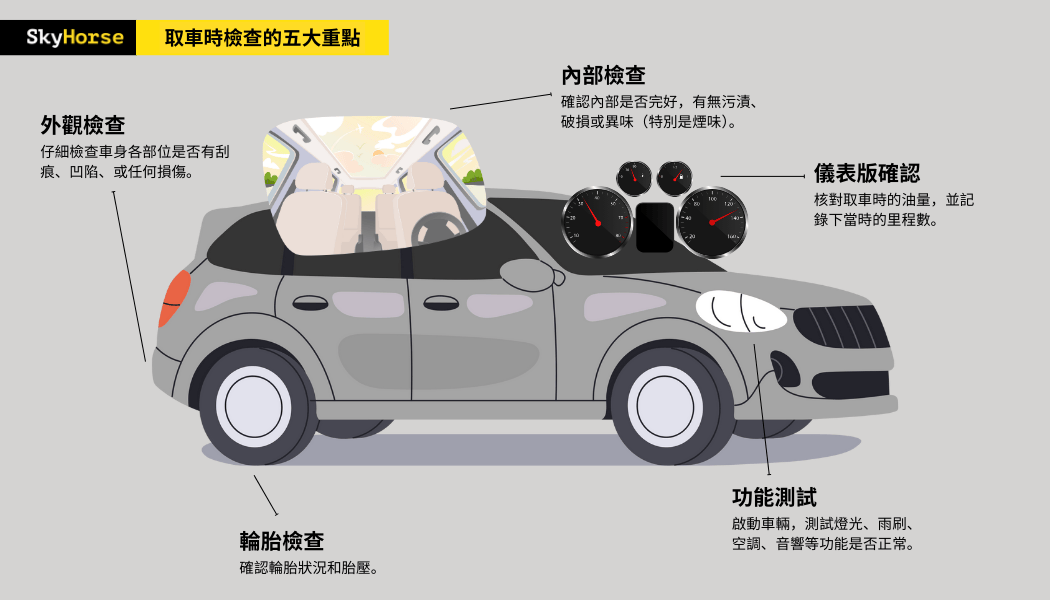
- Exterior Inspection: Inspect the car carefully for scratches, dents or other damages on all parts of the car and the windows/front and rear windshields, take photos or video records and point them out to the rental staff. Pay special attention to small scratches that can be easily overlooked in low-light conditions.
- Internal Inspection: Make sure that the interior upholstery of the seats, steering wheel, dashboard, etc. is in good condition, and check for stains, tears, or odors. Pay special attention to the smell of smoke, as this may result in a cleaning fee when returning the vehicle.
- Function Test: Start the vehicle and test for proper functioning of lights, wipers, air conditioning, and stereo. Verify that all major functions of the vehicle are functioning properly, especially safety-related functions such as brakes and lighting system.
- Tire Inspection: Check tire condition and pressure. Tires are an important safeguard for driving safety. Shallow tread or insufficient tire pressure can increase the risk of driving, especially on long trips.
- Dashboard ConfirmationCheck the fuel level at the time of pickup, which should normally be a full tank. If not, ask the staff to indicate the current fuel level on the contract, and record the mileage at the same time to avoid subsequent disputes.
If you find that the car model does not match, the car is not in good condition, there is a bad smell, dirty or damaged, please inform the rental company at the first time and ask them to replace the car or make a note of it on the paperwork, so that you can protect your own rights and interests.
Rental Fees and Common Hidden Fees
As I mentioned earlier that we need to pay attention to the fees in the contract, how do we know what are the normal car rental fees and what are the hidden fees that have been added?
The pricing structure of a rental car in the United States is complex. Understanding the components of these fees in the following pages will help you better recognize the details on your bill.
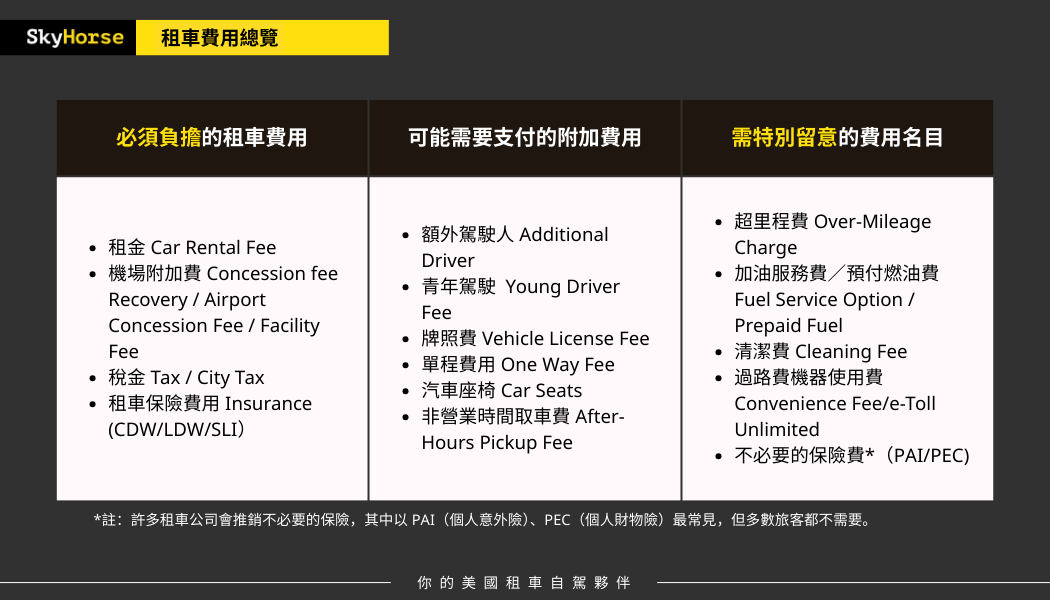
Car rental fees to be borne
- Rental: The daily rental fee multiplied by the number of days will be the rental cost of the car.
- Airport Surcharge: If you pick up your car from the airport, the rental car company will charge you a fee for operating or parking the car at the airport.
- Taxes: Rental tax rates vary by state, usually ranging from 6-11.51 TP3T of the total rental price.
- Car Rental Insurance: As mentioned above, you must have insurance to rent a car in the US, so there will be a fee for this.
Additional fees that may be payable
- Additional Driver: Adding an additional driver may cost $10-15 per day. If an accident occurs where the additional driver is not registered but is actually driven by a non-registered person, there is a high probability that the insurance will deny the claim.
- Young Driver Fee: Drivers between the ages of 21-24 usually pay a young driver surcharge of $25-35 per day. Some car rental companies even refuse service to drivers under the age of 24.
- License Fee: Some car rental companies charge a daily vehicle license fee ranging from $2-5.
- One Way Fee: If you choose to rent one way and return the other, you will usually be charged a one way fee, depending on the distance.
- Rental equipment: Rental of car seats, GPS, highway electronic toll collection equipment, snow chains, etc. from car rental companies.
- After Hours Pickup Fee: If you pick up your car during the rental company's after hours, you may be charged an after hours pickup fee.
Fees and charges that require special attention
- Excess Mileage Fee: If the contract has a mileage limit (e.g. 100-150 miles per day), the excess will be approximately $0.25-0.75 per mile. Although most U.S. car rental contracts offer unlimited mileage, there are still some companies or specific car models with mileage limits.
- Fuel Service Fee / Prepaid Fuel Fee: If you don't fill up your car as scheduled, the rental company will charge you more than the market rate for gas. Some companies will add a "prepaid fuel fee" in advance, so if you return the car with a full tank of gas, you will have to pay for two tanks of gas.
- Cleaning Fee: If the exterior or interior of the vehicle is excessively dirty or has an odor (e.g., smoke), you may be charged a high cleaning fee.
Other strange fees that have been charged on the internet include Road Safety Fee, Energy Fee and Administration Fee. Paying for services or equipment is a good idea, but the worst thing you can do is to be charged extra for services you didn't use, which will not only cost you money, but also the time and effort you will spend on communication, which is a cost you must be aware of when renting a car in the United States. Therefore, Sky Horse emphasizes on "price transparency" in order to make it easy for travelers to rent a car and drive in the U.S., so that they can make good memories of their trip without having to spend extra effort and bear these possible risks.
U.S. Driving Rules and Cultural Differences
Roads in the U.S. are usually wider, multi-lane, and the same as Taiwan are left-hand drive and drive on the right, many signs are also very similar, so understand some of the traffic rules and cultural differences between Taiwan and the U.S., most drivers feel that it's smoother and better to drive than in Taiwan.
Basic Transportation Rules
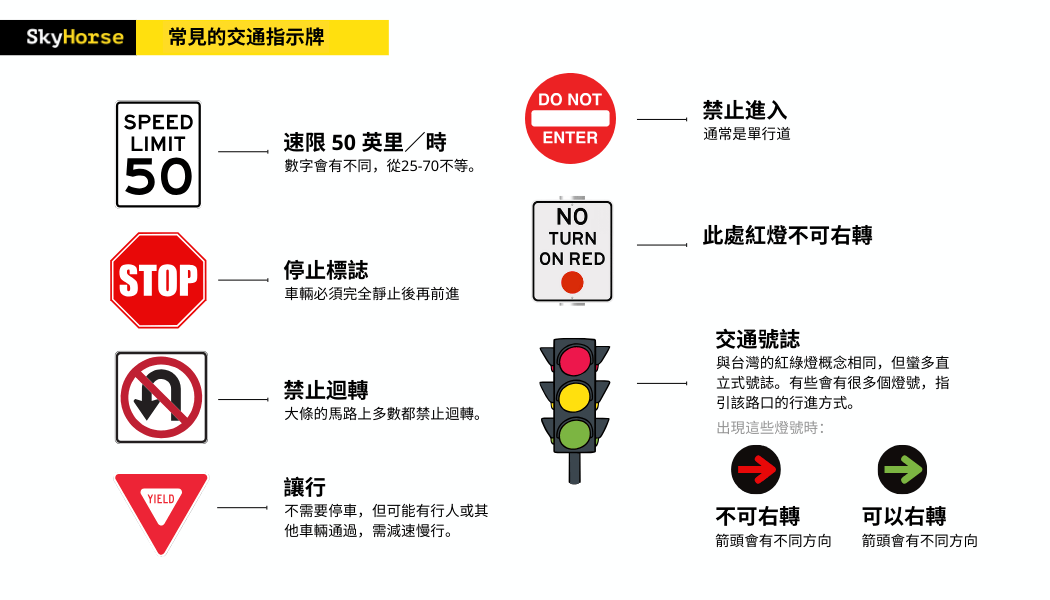
- Speed UnitThe mileage system is used in the United States, where 1 mile is equal to 1.6 kilometers, so don't mistake miles for kilometers and drive too slowly or too fast in places with speed limits.
- Red light, turn right.: At most intersections, you can turn right on a red light if you are sure it is safe to do so and if there are no special prohibitive signs. However, you must come to a complete stop and make sure that there are no oncoming vehicles or pedestrians on your left before you can make a right turn.
- Drive according to the sign: Some intersection signs are more complicated, with left-turn, straight ahead, and right-turn, so you need to follow the signs.
- turn around: If you are on a major road, you may only turn where there is a clearly marked sign or a designated turn lane.
- Stop SignVehicles must come to a complete standstill before proceeding. When more than one vehicle is arriving, the principle of first-come-first-served shall apply. If more than one vehicle arrives almost at the same time, the vehicle on the right will be allowed to go first.
- Pedestrian Priority: Pedestrians have absolute priority at zebra crossings and their safety should not be jeopardized, even in emergencies.
Highway Driving Tips
Driveway Use::
- The left lane is the overtaking lane. After overtaking, you should return to the right lane.
- Overtaking on the highway must be done from the left side of the road, avoiding overtaking from the right side.
- Some of the inner lanes will be labeled HOV, Carpool (High Occupancy Vehicle), which is only for vehicles with two or more passengers; there will also be some Tolled Lane and express lane, which have different restrictions, such as feasible time period, feasible vehicles, if you are unfamiliar with these lanes try not to use them as much as possible.
AC Navigation: The U.S. highway exit numbering system is clear and easy to navigate by exit number. There are usually 1-mile and 0.5-mile signs in front of the exits of interchanges, giving drivers enough time to prepare for changing lanes. It is important to note that most interchanges in Taiwan are on the right side of the road, but this is not necessarily the case in the U.S. Sometimes the same freeway system may connect to different exits on the left, center, or right side of the road.
safe driving distance: Maintain a safe distance of at least 3 seconds from the vehicle in front. At high speeds, an adequate safety distance provides more reaction time and reduces the risk of an accident.
Speed limit complianceSpeed limits on U.S. highways range from 55 - 70 mph (88 - 112 km/h). Speed cameras are not common on roads, but there are police officers on the road to measure speed, and if you are penalized for violating the law, you will be fined differently depending on the speeding range, but the fines are usually very high!
🚧 Warm reminder: Recently, on the highway "Las Vegas -> Grand Canyon -> Antelope Canyon", there are often police officers on the road to measure the speed, don't speed just because the road is straight and there are fewer cars, otherwise you will have to eat hundreds of dollars in tickets!
Handling of Special Traffic Situations
- Stopping for school buses: When you see a yellow school bus stopping and displaying a STOP sign, unless the road is physically separated, vehicles in both directions must stop and wait, do not go around. This is a strict U.S. law, and violations may result in heavy fines or suspension of your driver's license.
- Yield to Emergency Vehicles: Yield the right-of-way immediately when you hear the siren of a police car, fire truck, or ambulance.
- Stopped by the police.: Remain calm, turn on the warning lights and pull over to the side of the road. Turn off the engine, put your hands on the steering wheel and wait for the police to tell you what to do. Wait for the police to approach and tell you what you need to do. Do not get out of the car or make any movement that could be interpreted as a threat. When approached by the police, provide your driver's license and rental car documents in a courteous manner, and answer the police officer's questions briefly. Be friendly and concise, and do not argue or defend yourself.
The terrain and driving habits vary from region to region. For example, in California's big cities, traffic is more congested and driving is more urgent, so be aware of serious traffic jams during peak hours in Los Angeles, and know the tips and regulations for stopping on steep slopes in San Francisco.
For more information, please refer to our articles on these two cities:
Five Steps to Avoiding Disputes
After the end of the trip to return the car, do not directly drive the car back to the park as the completion of the return of the car, the following five steps to help you avoid subsequent disputes and disputes.
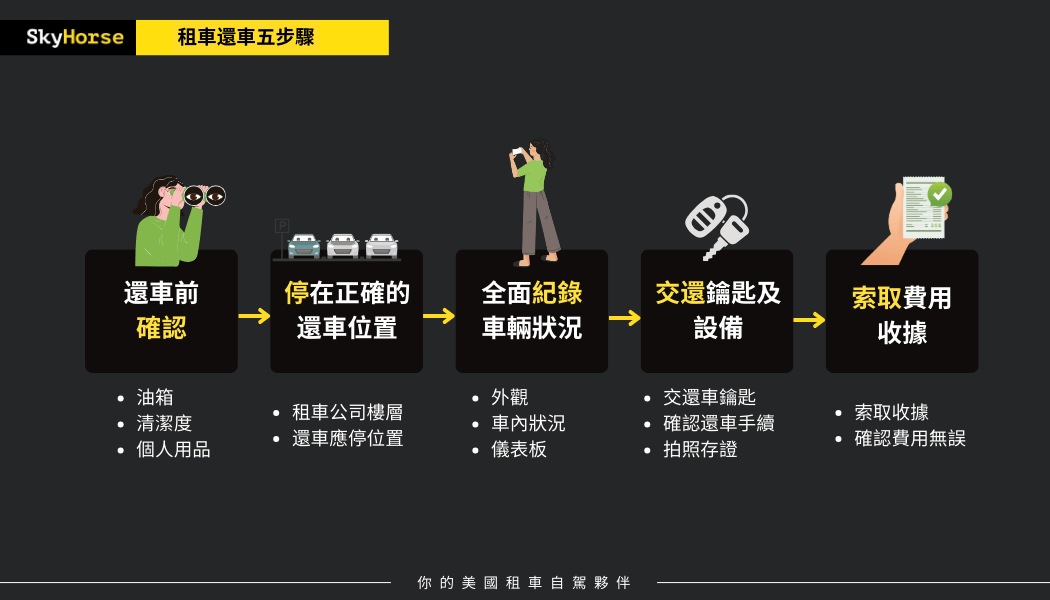
- Confirm before returning the car.
Please check three things before returning the car: fuel tank, cleanliness, and personal items. According to the contract, you need to return the car with a full tank of gas. If the tank is not full, you will be charged extra fuel and service fees, which are usually much higher than the market price. If the rental car causes serious dirt or odor, the rental company has the right to charge a cleaning fee. Therefore, if you are going to the wilderness, or if you have food or excessive garbage in the car, it is recommended that you drive to a self-service car wash to clean it up a little bit, and dispose of the personal garbage on your own, so as to avoid the extra cleaning fee. Lastly, make sure you take out all your personal belongings, especially the cables that are easy to forget.
- Finding the right place to return the car
Different car rental companies may have different drop-off and pick-up locations on different floors, so make sure you check in advance to avoid making a mistake. Especially at large airports, the return areas of different car rental companies may be scattered in different areas. If you have a flight to take next, please allow more time to return the car. Sometimes, the parking lot is crowded with cars, so it takes a lot of time to return the car and find a parking space, and then you may have to take a shuttle bus to the terminal again.
- Comprehensive record of the vehicle's internal and external conditions
Take a video or photo record of the cleaned, personalized vehicle in the condition it was returned in, including the exterior, interior, and dashboard (especially the mileage and gas gauges) to avoid any subsequent disputes.
- Returning Keys and Rental Equipment
Return the keys to the rental agent to confirm that the return procedure is complete. Some car rental companies that do not have staff after hours may ask you to put the keys in a box and take a photo of the return.
- Request for Fee Receipts
It is a good idea to ask for a receipt directly from the rental company after returning the car. Make sure you receive a receipt detailing all charges and keep it for at least 30 days. This receipt will be important evidence in case of any unauthorized deductions in the future. Some companies provide electronic receipts by email, so make sure you get one that doesn't have hidden charges added to it. (These incidents are common in the U.S., and not just among foreign travelers, but since it's more difficult for travelers to recover overcharges when they return to their home country, they tend to brush it off as a bad deal.)
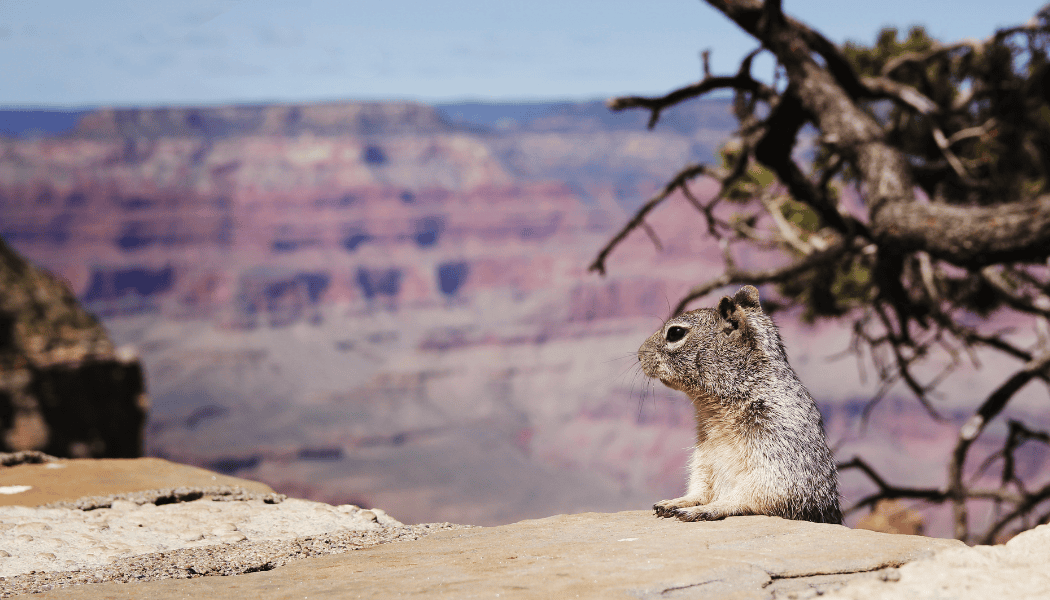
Renting a car and driving in the U.S. is probably the best way to experience the country. Though you may face differences in language, rules and habits during the process, your U.S. driving trip will be enjoyable and safe with adequate preparation and appropriate choices. We care about every detail of the traveler's experience, from evaluating the right car rental company and car model, to understanding the coverage of various types of insurance; to familiarizing yourself with the U.S. driving rules, and mastering the precautions to be taken when picking up and returning the car, we hope that this detailed information can help you to plan your U.S. travel with full confidence and anticipation!
Last but not least, we would like to remind you that Sky Horse's full Chinese car rental service can help you save most of the trouble of renting a car, language is no longer a challenge to travel, and the professional and caring team will give you comprehensive support before, during, and after the rental of a car. Sky Horse is looking forward to accompanying you and leaving the most handsome and beautiful memories for your U.S. driving trip with your family and friends.
If you have any questions about this guide or the rental process, please feel free to contact us directly.Contact us via LINEThe
